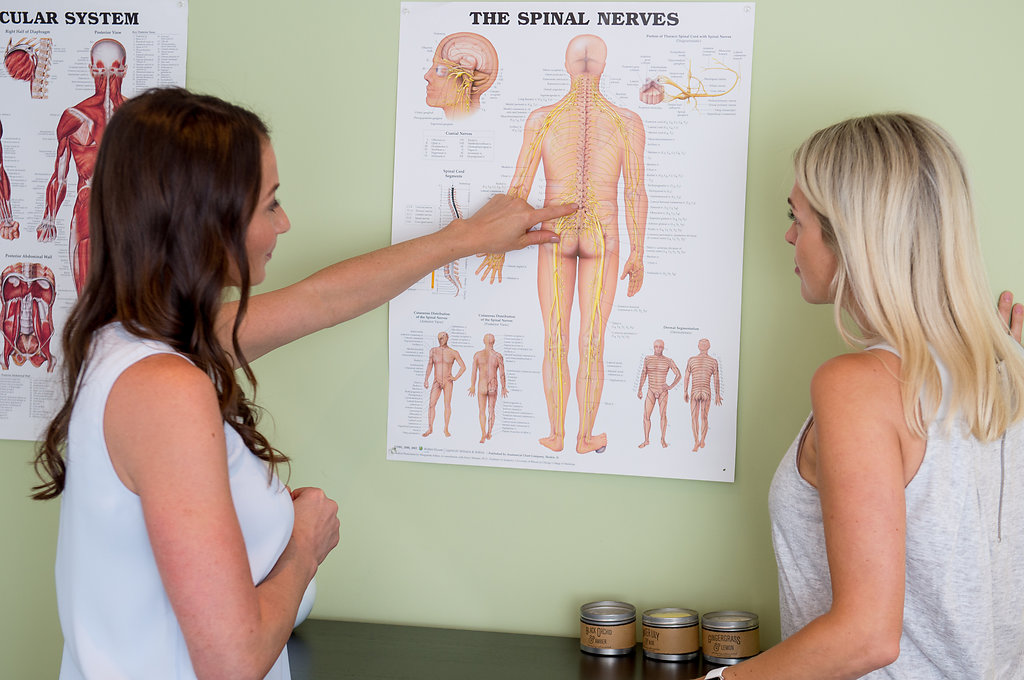
Why is spinal health important?
The spinal column is comprised of 24 vertebral bones and a tail bone (sacrum) which are separated by discs that act as “shock absorbers” for the spine. These bones move separately and independently from one another by structures called facet joints, which should always be mobile and flexible.
The body’s nervous system (brain, spinal cord and spinal nerves) is encased in and protected by the spinal column. The nervous system travels out between the vertebrae or joints of the spine to carry messages from the brain to every cell, muscle and organ in the human body and as a result is known as the “control center.” In order for the nervous system to function properly, a well aligned spinal column moving with a full range of motion is necessary. Stress and strain on the spine can put pressure on the nerves in the affected area, leading to pain.
Activities which cause joints of the spine and body to function and move improperly include: stress and strain of everyday life (think driving, texting, poor posture at work), occupational stress, car accidents, repetitive strain, sedentary work life, sports injuries, emotional stress or even improper sleeping positions. These life “stressors” cause muscles in the back and neck to tighten which in turn restricts spinal joints. Tight, immobile joints eventually put pressure on the nerves exiting from them. This triad of events is called a subluxation and eventually results in pain and dysfunction. Chiropractors restore mobility in these restricted joints and promote spinal health through gentle adjustments.
What is an adjustment?
Doctors of chiropractic are the only regulated health care practitioners who are properly trained and educated to administer chiropractic adjustments. Adjustments of the joints of the body have been used in the healing arts for many centuries and is at the heart of modern chiropractic care.
When joints of the spine and musculoskeletal system are restricted, a reaction is created in the surrounding ligaments, muscles and nerves which results in pain, dysfunction and muscular spasm. An adjustment is a highly skilled, precise and controlled maneuver, that is administered by hand (Diversified Technique) or instrument (Activator Technique) to a restricted joint of the body to restore proper mobility. This safe, gentle, drug free procedure decreases pain by reducing stress on neurological tissue and brings the body into a state of better mobility, better health, and balance.
Chiropractors restore normal mobility of the spine and body through adjustments, allowing the nervous system to function without interference.
Techniques used by Dr. Pam:
- Diversified Technique (Hands on/traditional chiropractic adjustments)
- Activator (Low force instrument adjustments)
- Joint mobilizations (Spinal and extremities)
- Thompson Technique (Low force)
- Myofascial/Active Release Technique
- Trigger Point Therapy/Acupressure
- Acupuncture
- Graston (Instrument-assisted soft tissue mobilization which effectively breaks down scar tissue and fascial restrictions)
- Webster Technique
Do chiropractors “crack” your bones?
There is a common misconception that chiropractors “crack” backs or “align” spines which are false beliefs. The purpose of the adjustment is solely to restore normal motion in joints which in turn removes nervous interference. If the adjustment is administered manually (by hand), there is an audible release, which is simply nitrogen gas being released from the synovial joint that is being mobilized. Dr. Pam also uses instruments to achieve the same result for those individuals who are not comfortable with manual techniques. Instrument adjusting is a low force, gentle technique which is even safe for babies and those with fragile spines such as individuals with osteoporosis. Dr. Pam will discuss which treatment protocol is best suited for each patient.
Is it true that once you start seeing a chiropractor you have to keep going?
Chiropractic care isn’t addictive. Dr. Pam will advise the frequency of treatments that are necessary to correct your problem. Maintenance care is always recommended to ensure that your spine and nervous system are always functioning optimally. Dr. Pam likes to use the analogy of car maintenance. You don’t wait for your car to break down before getting the oil changed. In the same way, it is advised to get spinal “tune ups” so that you never have to experience pain in the first place. How long you benefit from chiropractic care is always up to you!
Are chiropractors real doctors?
Chiropractors have to complete a minimum of 7 years education, including 3 years of University followed by a rigorous 4 year chiropractic program. There are over 4400 hours of education/training, including research, x-ray training, methodology and critical review courses. We are interns for a year before graduating and we work on real patients under the supervision of a licensed chiropractor. We are skilled in assessing, diagnosing, treating and preventing all musculoskeletal problems, which earns us the Doctor title.
Do you have to be referred to a chiropractor by a medical doctor?
You do not. Anyone can seek the help of a chiropractor on their own terms without the referral of a medical doctor.
Does OHIP cover chiropractic?
OHIP does not assist in coverage but most employee benefits packages cover chiropractic care up to a certain point. You can call your provider to see how much chiropractic coverage you are allotted each year. After each visit Dr. Pam will issue you an official receipt which includes her registration number to ensure you are reimbursed through your plan. These days most insurance companies offer online submission, which means that reimbursement from treatments occurs within 1-2 business days.
How long does it take to get relief from a chiropractor?
Most patients experience relief after the first visit. Others discover it can take many weeks or months. Many factors can affect the healing process. How long have you had your problem? Are you keeping your appointments? Are you getting the proper rest, exercise and nutrition? Do you smoke? Are you in otherwise good condition? Dr. Pam’s initial treatment protocol is to perform 4 treatments relatively close together (2 treatments per week for 2 weeks) followed by a reassessment to determine progress. If the symptoms are resolving then the treatments are gradually spaced out until the patient is recommended a maintenance program, which is optional and differs for each person. Dr. Pam feels that her duty as a chiropractor is to educate patients on the importance of maintenance care, but stresses that how you benefit from chiropractic care is completely your choice. With physical, environmental and emotional stressors in life, it’s advisable not to go longer than a month for a spinal “tune up.”
Can you adjust yourself?
No. Some people can make their joints “pop” but that’s not an adjustment! Adjustments are high velocity low amplitude specific maneuvers that take years to master. Even Dr. Pam must consult a colleague to benefit from chiropractic care.
Will the treatment hurt?
Most patients report a sense of well-being or a feeling of calmness. Some report feeling energized and “lighter” and many patients have reported getting an amazing night’s sleep the day of their adjustment. Since repeated adjustments are necessary, if adjustments didn’t feel good, patients wouldn’t return to finish their care. Chiropractors are experts at making adjustments feel good. Many times patients have reported to Dr. Pam that it’s their “favorite part of the day” or they “couldn’t wait for their adjustment, had been looking forward to it all day”, etc. There may be mild soreness or a bruised feeling after the first one or two treatments which may feel like you’ve had a workout. It’s mostly due to the soft tissue component of the treatment, which involves breaking up scar tissue in muscles, and is your body’s way of getting used to a different (better) way of functioning. Any discomfort is mild and temporary.
Do you have to be in pain to see a chiropractor?
Absolutely not. If you have a spine then chiropractic care will be beneficial for you. Symptoms are simply the tip of the iceberg. Too many times chiropractors hear in their offices: “I didn’t do anything to warrant this pain”, “I just woke up and the pain was there”, “But I’ve always sat for 10 hours a day with no problem” or “I’ve been running for years without discomfort.” Our bodies are designed to be very resilient and adaptive to the stressors that we are exposed to each and everyday and we all have an innate ability to heal, adapt and compensate. However, underlying problems are present far longer than the symptoms actually surface and chiropractors serve a vital role in preventative care; where the sole purpose is to proactively ensure that the spinal column is functioning with full mobility so that symptoms never arise.
Yes it is true that chiropractors alleviate pain and dysfunction in the musculoskeletal system, but we offer so much more. Through maintenance care, we are allowing the body to function at it’s optimal capacity so that you can go through life feeling stronger, more energetic and agile, and ultimately happier. A healthy body is key for a healthy mind and chiropractors are specialists in removing interference between the brain body connection. It’s really that simple.
Is chiropractic dangerous for the elderly?
 Absolutely not! In fact quite the opposite. Chiropractic care is especially important for the aging population because of the dramatic changes that occur in the spine and musculoskeletal system. As we age, spinal discs, joints, ligaments, muscles and other spinal tissues become weaker, less hydrated, more fibrous, and less able to withstand normal strain. As a result, aging makes us more prone to certain disease conditions such as arthritis and osteoporosis. Chiropractors are specialists in promoting and maintaining movement in the body and can help address and correct musculoskeletal injuries to increase the quality of life as we age.
Absolutely not! In fact quite the opposite. Chiropractic care is especially important for the aging population because of the dramatic changes that occur in the spine and musculoskeletal system. As we age, spinal discs, joints, ligaments, muscles and other spinal tissues become weaker, less hydrated, more fibrous, and less able to withstand normal strain. As a result, aging makes us more prone to certain disease conditions such as arthritis and osteoporosis. Chiropractors are specialists in promoting and maintaining movement in the body and can help address and correct musculoskeletal injuries to increase the quality of life as we age.
Modern chiropractic procedures take into consideration the nature of the aging spine to provide an effective, safe and non-invasive treatment plan. Through the use of gentle adjusting techniques, physical therapies, and incorporation of stretching and exercise programs, spinal pain is reduced, spinal stresses are decreased, overall flexibility and mobility are improved, and degeneration is minimized.
Chiropractic care for the elderly has been proven to:
- Increase range of motion and mobility
- Improve function
- Help decrease progression of joint degeneration and arthritis
- Correct posture
- Increase balance and coordination
- Reduce the risk of falls
- Decrease muscle stiffness, spasms and rigidity
- Increase sense of well-being and overall energy
It is found that elderly people who seek the care of chiropractors are:
- More likely to report better health
- Less likely to be hospitalized
- Less likely to enter nursing homes
- Less likely to require prescription drugs
- More active in their communities
Can pregnant women receive chiropractic treatment?
Absolutely! During pregnancy, there are mechanical and hormonal changes that occur to create an optimal environment for the developing baby. These changes include a protruding abdomen and increased back (lordotic) curve as well as pelvic changes and postural adaptations. This results in added stress and discomfort in the spine and joints. Chiropractors are trained to alleviate the common problems associated with pregnancy such as sciatica (shooting pain down one or both legs due to pressure on low back vertebrae and nerves), low back pain, carpal tunnel syndrome as well as pain and tension in the pelvis, sacrum, hips, knees and feet.
Dr. Pam uses specialized adjustment techniques to accommodate pregnancy that are gentle and non-invasive. These treatments not only reduce the pain and discomfort associated with pregnancy, but may also reduce the need for pain medications throughout the delivery. Some evidence suggests that chiropractic treatment during pregnancy helps to reduce labor time and makes the birth process easier. Follow up treatments can assist in realigning the body after pregnancy, speeding the transition to a healthy post-pregnancy body and addressing postpartum issues such as stress and tension of breastfeeding and being a new mom.
Dr. Pam is also trained and certified in the Webster Technique.
Potential benefits of chiropractic care during pregnancy include:
- Maintaining a healthier pregnancy
- Controlling symptoms of nausea
- Reducing the time of labor and delivery
- Relieving back, neck or joint pain
- Preventing a potential cesarean delivery
Is chiropractic scientific?
How do you define “scientific?”
If you define it as the systematic pursuit of knowledge involving the recognition of a problem, the collection of data through observation and experiment and then testing the resulting hypotheses, then today’s chiropractic is quite scientific. It’s based on the scientific fact that the nervous system controls and regulates virtually every cell, tissue, organ and system of the body.
There are a growing number of studies that suggest the chiropractic approach to reducing nerve disturbance along the spine, may enhance the ability of the brain and nerve system to control and regulate the body.
These include published research documenting the results of chiropractic care on asthma, infantile colic, immune function, dysmenorrhea (menstrual cramps), improving vision and brain function, lower back pain, one’s overall health status and many others.
The “scientific” argument is largely a red herring and the sign of a double standard. Medical economist David Eddy, MD, Ph.D., observes that only 15% of medical procedures have ever been scientifically verified, and the other 85% of common medical procedures have no “scientific basis!”
Ultimately, the proof is in the pudding. Ask Dr. Pam’s delighted patients whether chiropractic is scientific.


